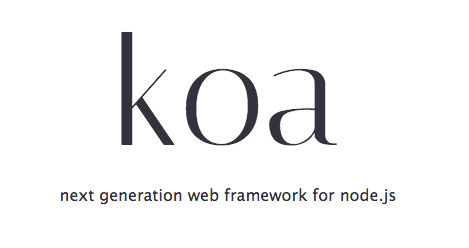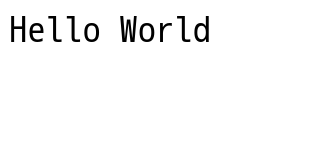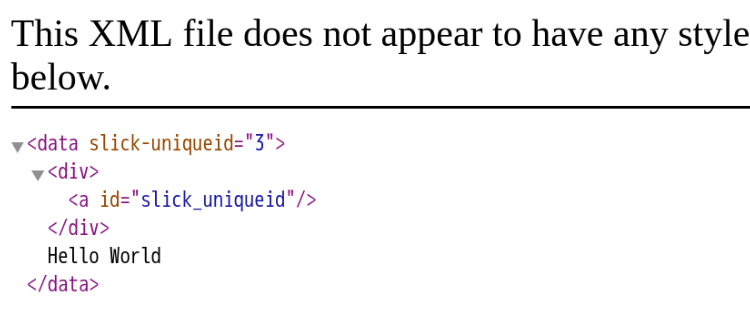Koa框架教程
Node主要用在開發 Web 應用。這決定了使用 Node,往往離不開 Web 應用框架。

Koa 就是一種簡單好用的 Web 框架。它的特點是優雅、簡潔、表達力強、自由度高。本身代碼只有1000多行,所有功能都通過插件實現,很符合 Unix 哲學。
本文從零開始,循序漸進,教會你如何使用 Koa 寫出自己的 Web 應用。每一步都有簡潔易懂的示例,希望讓大家一看就懂。
零、準備
首先,檢查 Node 版本。
$ node -v v8.0.0
Koa 必須使用 7.6 以上的版本。如果你的版本低於這個要求,就要先升級 Node。
然後,克隆本文的配套示例庫。(如果不方便使用 Git,也可以下載 zip 文件解壓。)
$ git clone https://github.com/ruanyf/koa-demos.git
接著,進入示例庫,安裝依賴。
$ cd koa-demos $ npm install
所有示例源碼,都在 demos 目錄下面。當然,我在這裏每個示例都有自已運行了一遍,也可直接從附件下載所有示例代碼。
一.基本用法
1.1 架設 HTTP 服務
只要三行代碼,就可以用 Koa 架設一個 HTTP 服務。
// 01.js const Koa = require(‘koa‘); const app = new Koa(); app.listen(3000);
運行這個腳本。
$ node 01.js
打開瀏覽器,訪問 http://127.0.0.1:3000 。你會看到頁面顯示"Not Found",表示沒有發現任何內容。這是因為我們並沒有告訴 Koa 應該顯示什麽內容。

1.2 Context 對象
Koa 提供一個 Context 對象,表示一次對話的上下文(包括 HTTP 請求和 HTTP 回復)。通過加工這個對象,就可以控制返回給用戶的內容。
Context.response.body屬性就是發送給用戶的內容。請看下面的例子。
// 02.js const Koa = require(‘koa‘); const app = new Koa(); const main = ctx => { ctx.response.body = ‘Hello World‘; }; app.use(main); app.listen(3000);
上面代碼中,main函數用來設置ctx.response.body。然後,使用app.use方法加載main函數。
你可能已經猜到了,ctx.response代表 HTTP Response。同樣地,ctx.request代表 HTTP Request。
運行這個腳本。
$ node 02.js
訪問 http://127.0.0.1:3000 ,現在就可以看到"Hello World"了。

1.3 HTTP Response 的類型
Koa 默認的返回類型是text/plain,如果想返回其他類型的內容,可以先用ctx.request.accepts判斷一下,客戶端希望接受什麽數據(根據 HTTP Request 的Accept字段),然後使用ctx.response.type指定返回類型。請看下面的例子。
// 03.js const main = ctx => { if (ctx.request.accepts(‘xml‘)) { ctx.response.type = ‘xml‘; ctx.response.body = ‘<data>Hello World</data>‘; } else if (ctx.request.accepts(‘json‘)) { ctx.response.type = ‘json‘; ctx.response.body = { data: ‘Hello World‘ }; } else if (ctx.request.accepts(‘html‘)) { ctx.response.type = ‘html‘; ctx.response.body = ‘<p>Hello World</p>‘; } else { ctx.response.type = ‘text‘; ctx.response.body = ‘Hello World‘; } };
運行這個腳本。
$ node 03.js
訪問 http://127.0.0.1:3000 ,現在看到的就是一個 XML 文檔了。

1.4 網頁模板
實際開發中,返回給用戶的網頁往往都寫成模板文件。我們可以讓 Koa 先讀取模板文件,然後將這個模板返回給用戶。請看下面的例子。
// 04.js const fs = require(‘fs‘); const main = ctx => { ctx.response.type = ‘html‘; ctx.response.body = fs.createReadStream(‘./demos/template.html‘); };
運行這個腳本。
$ node 04.js
訪問 http://127.0.0.1:3000 ,看到的就是模板文件的內容了。

二、路由
2.1 原生路由
網站一般都有多個頁面。通過ctx.request.path可以獲取用戶請求的路徑,由此實現簡單的路由。請看下面的例子。
// 05.js const main = ctx => { if (ctx.request.path !== ‘/‘) { ctx.response.type = ‘html‘; ctx.response.body = ‘<a href="/">Index Page</a>‘; } else { ctx.response.body = ‘Hello World‘; } };
運行這個腳本。
$ node 05.js
訪問 http://127.0.0.1:3000/about ,可以看到一個鏈接,點擊後就跳到首頁。

2.2 koa-route 模塊
原生路由用起來不太方便,我們可以使用封裝好的koa-route模塊。請看下面的例子。
// 06.js const route = require(‘koa-route‘); const about = ctx => { ctx.response.type = ‘html‘; ctx.response.body = ‘<a href="/">Index Page</a>‘; }; const main = ctx => { ctx.response.body = ‘Hello World‘; }; app.use(route.get(‘/‘, main)); app.use(route.get(‘/about‘, about));
上面代碼中,根路徑/的處理函數是main,/about路徑的處理函數是about。
運行這個腳本。
$ node 06.js
訪問 http://127.0.0.1:3000/about ,效果與上一個例子完全相同。
2.3 靜態資源
如果網站提供靜態資源(圖片、字體、樣式表、腳本......),為它們一個個寫路由就很麻煩,也沒必要。koa-static模塊封裝了這部分的請求。請看下面的例子。
// 12.js const path = require(‘path‘); const serve = require(‘koa-static‘); const main = serve(path.join(__dirname)); app.use(main);
運行這個腳本。
$ node 12.js
訪問 http://127.0.0.1:3000/12.js,在瀏覽器裏就可以看到這個腳本的內容。
2.4 重定向
有些場合,服務器需要重定向(redirect)訪問請求。比如,用戶登陸以後,將他重定向到登陸前的頁面。ctx.response.redirect()方法可以發出一個302跳轉,將用戶導向另一個路由。請看下面的例子。
// 13.js const redirect = ctx => { ctx.response.redirect(‘/‘); ctx.response.body = ‘<a href="/">Index Page</a>‘; }; app.use(route.get(‘/redirect‘, redirect));
運行這個腳本。
$ node demos/13.js
訪問 http://127.0.0.1:3000/redirect ,瀏覽器會將用戶導向根路由。
三.中間件
3.1 Logger 功能
Koa 的最大特色,也是最重要的一個設計,就是中間件(middleware)。為了理解中間件,我們先看一下 Logger (打印日誌)功能的實現。
最簡單的寫法就是在main函數裏面增加一行。
// demos/07.js const main = ctx => { console.log(`${Date.now()} ${ctx.request.method} ${ctx.request.url}`); ctx.response.body = ‘Hello World‘; };
運行這個 Demo。
$ node demos/07.js
訪問 http://127.0.0.1:3000 ,命令行就會輸出日誌。
1502144902843 GET /
3.2 中間件的概念
上一個例子裏面的 Logger 功能,可以拆分成一個獨立函數(完整代碼看這裏)。
// demos/08.js const logger = (ctx, next) => { console.log(`${Date.now()} ${ctx.request.method} ${ctx.request.url}`); next(); } app.use(logger);
像上面代碼中的logger函數就叫做"中間件"(middleware),因為它處在 HTTP Request 和 HTTP Response 中間,用來實現某種中間功能。app.use()用來加載中間件。
基本上,Koa 所有的功能都是通過中間件實現的,前面例子裏面的main也是中間件。每個中間件默認接受兩個參數,第一個參數是 Context 對象,第二個參數是next函數。只要調用next函數,就可以把執行權轉交給下一個中間件。
運行這個 demo。
$ node demos/08.js
訪問 http://127.0.0.1:3000 ,命令行窗口會顯示與上一個例子相同的日誌輸出。
3.3 中間件棧
多個中間件會形成一個棧結構(middle stack),以"先進後出"(first-in-last-out)的順序執行。
- 最外層的中間件首先執行。
- 調用
next函數,把執行權交給下一個中間件。- ...
- 最內層的中間件最後執行。
- 執行結束後,把執行權交回上一層的中間件。
- ...
- 最外層的中間件收回執行權之後,執行
next函數後面的代碼。
請看下面的例子(完整代碼看這裏)。
// demos/09.js const one = (ctx, next) => { console.log(‘>> one‘); next(); console.log(‘<< one‘); } const two = (ctx, next) => { console.log(‘>> two‘); next(); console.log(‘<< two‘); } const three = (ctx, next) => { console.log(‘>> three‘); next(); console.log(‘<< three‘); } app.use(one); app.use(two); app.use(three);
運行這個 demo。
$ node demos/09.js
訪問 http://127.0.0.1:3000 ,命令行窗口會有如下輸出。
>> one >> two >> three << three << two << one
如果中間件內部沒有調用next函數,那麽執行權就不會傳遞下去。作為練習,你可以將two函數裏面next()這一行註釋掉再執行,看看會有什麽結果。
3.4 異步中間件
迄今為止,所有例子的中間件都是同步的,不包含異步操作。如果有異步操作(比如讀取數據庫),中間件就必須寫成 async 函數。請看下面的例子(完整代碼看這裏)。
// demos/10.js const fs = require(‘fs.promised‘); const Koa = require(‘koa‘); const app = new Koa(); const main = async function (ctx, next) { ctx.response.type = ‘html‘; ctx.response.body = await fs.readFile(‘./demos/template.html‘, ‘utf8‘); }; app.use(main); app.listen(3000);
上面代碼中,fs.readFile是一個異步操作,必須寫成await fs.readFile(),然後中間件必須寫成 async 函數。
運行這個 demo。
$ node demos/10.js
訪問 http://127.0.0.1:3000 ,就可以看到模板文件的內容。
3.5 中間件的合成
koa-compose模塊可以將多個中間件合成為一個。請看下面的例子(完整代碼看這裏)。
// demos/11.js const compose = require(‘koa-compose‘); const logger = (ctx, next) => { console.log(`${Date.now()} ${ctx.request.method} ${ctx.request.url}`); next(); } const main = ctx => { ctx.response.body = ‘Hello World‘; }; const middlewares = compose([logger, main]); app.use(middlewares);
運行這個 demo。
$ node demos/11.js
訪問 http://127.0.0.1:3000 ,就可以在命令行窗口看到日誌信息。
四、錯誤處理
4.1 500 錯誤
如果代碼運行過程中發生錯誤,我們需要把錯誤信息返回給用戶。HTTP 協定約定這時要返回500狀態碼。Koa 提供了ctx.throw()方法,用來拋出錯誤,ctx.throw(500)就是拋出500錯誤。請看下面的例子(完整代碼看這裏)。
// demos/14.js const main = ctx => { ctx.throw(500); };
運行這個 demo。
$ node demos/14.js
訪問 http://127.0.0.1:3000,你會看到一個500錯誤頁"Internal Server Error"。

4.2 404錯誤
如果將ctx.response.status設置成404,就相當於ctx.throw(404),返回404錯誤。請看下面的例子(完整代碼看這裏)。
// demos/15.js const main = ctx => { ctx.response.status = 404; ctx.response.body = ‘Page Not Found‘; };
運行這個 demo。
$ node demos/15.js
訪問 http://127.0.0.1:3000 ,你就看到一個404頁面"Page Not Found"。

4.3 處理錯誤的中間件
為了方便處理錯誤,最好使用try...catch將其捕獲。但是,為每個中間件都寫try...catch太麻煩,我們可以讓最外層的中間件,負責所有中間件的錯誤處理。請看下面的例子(完整代碼看這裏)。
// demos/16.js const handler = async (ctx, next) => { try { await next(); } catch (err) { ctx.response.status = err.statusCode || err.status || 500; ctx.response.body = { message: err.message }; } }; const main = ctx => { ctx.throw(500); }; app.use(handler); app.use(main);
運行這個 demo。
$ node demos/16.js
訪問 http://127.0.0.1:3000 ,你會看到一個500頁,裏面有報錯提示 {"message":"Internal Server Error"}。

4.4 error 事件的監聽
運行過程中一旦出錯,Koa 會觸發一個error事件。監聽這個事件,也可以處理錯誤。請看下面的例子(完整代碼看這裏)。
// demos/17.js const main = ctx => { ctx.throw(500); }; app.on(‘error‘, (err, ctx) => console.error(‘server error‘, err); );
運行這個 demo。
$ node demos/17.js
訪問 http://127.0.0.1:3000 ,你會在命令行窗口看到"server error xxx"。
4.5 釋放 error 事件
需要註意的是,如果錯誤被try...catch捕獲,就不會觸發error事件。這時,必須調用ctx.app.emit(),手動釋放error事件,才能讓監聽函數生效。請看下面的例子(完整代碼看這裏)。
// demos/18.js` const handler = async (ctx, next) => { try { await next(); } catch (err) { ctx.response.status = err.statusCode || err.status || 500; ctx.response.type = ‘html‘; ctx.response.body = ‘<p>Something wrong, please contact administrator.</p>‘; ctx.app.emit(‘error‘, err, ctx); } }; const main = ctx => { ctx.throw(500); }; app.on(‘error‘, function(err) { console.log(‘logging error ‘, err.message); console.log(err); });
上面代碼中,main函數拋出錯誤,被handler函數捕獲。catch代碼塊裏面使用ctx.app.emit()手動釋放error事件,才能讓監聽函數監聽到。
運行這個 demo。
$ node demos/18.js
訪問 http://127.0.0.1:3000 ,你會在命令行窗口看到logging error。
五、Web App 的功能
5.1 Cookies
ctx.cookies用來讀寫 Cookie。請看下面的例子(完整代碼看這裏)。
// demos/19.js const main = function(ctx) { const n = Number(ctx.cookies.get(‘view‘) || 0) + 1; ctx.cookies.set(‘view‘, n); ctx.response.body = n + ‘ views‘; }
運行這個 demo。
$ node demos/19.js
訪問 http://127.0.0.1:3000 ,你會看到1 views。刷新一次頁面,就變成了2 views。再刷新,每次都會計數增加1。

5.2 表單
Web 應用離不開處理表單。本質上,表單就是 POST 方法發送到服務器的鍵值對。koa-body模塊可以用來從 POST 請求的數據體裏面提取鍵值對。請看下面的例子(完整代碼看這裏)。
// demos/20.js const koaBody = require(‘koa-body‘); const main = async function(ctx) { const body = ctx.request.body; if (!body.name) ctx.throw(400, ‘.name required‘); ctx.body = { name: body.name }; }; app.use(koaBody());
運行這個 demo。
$ node demos/20.js
打開另一個命令行窗口,運行下面的命令。
$ curl -X POST --data "name=Jack" 127.0.0.1:3000 {"name":"Jack"} $ curl -X POST --data "name" 127.0.0.1:3000 name required
上面代碼使用 POST 方法向服務器發送一個鍵值對,會被正確解析。如果發送的數據不正確,就會收到錯誤提示。
2.3 文件上傳
koa-body模塊還可以用來處理文件上傳。請看下面的例子(完整代碼看這裏)。
// demos/21.js const os = require(‘os‘); const path = require(‘path‘); const koaBody = require(‘koa-body‘); const main = async function(ctx) { const tmpdir = os.tmpdir(); const filePaths = []; const files = ctx.request.body.files || {}; for (let key in files) { const file = files[key]; const filePath = path.join(tmpdir, file.name); const reader = fs.createReadStream(file.path); const writer = fs.createWriteStream(filePath); reader.pipe(writer); filePaths.push(filePath); } ctx.body = filePaths; }; app.use(koaBody({ multipart: true }));
運行這個 demo。
$ node demos/21.js
打開另一個命令行窗口,運行下面的命令,上傳一個文件。註意,/path/to/file要更換為真實的文件路徑。
$ curl --form upload=@/path/to/file http://127.0.0.1:3000 ["/tmp/file"]
Koa框架教程
